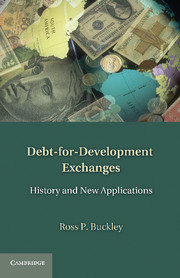Book contents
- Frontmatter
- Contents
- Acknowledgments
- List of Contributors
- Introduction: A Productive Partnership between Civil Society and the Academy
- Part I Types of Exchanges and Their Development over Time
- Part II Exchanges by Donor Countries
- Part III Critiques of Exchanges
- Part IV Innovative Applications of Exchanges
- 15 Farmer-Managed Natural Regeneration: A Land Rehabilitation Technique Well Adapted to Funding by Exchanges
- 16 Restoring Mangroves in the Philippines
- 17 Poverty Reduction through Social Protection: A Potential Form of Debt-for-Development Exchange
- 18 Climate Change Adaptation Exchanges: An Exploration of the Possibilities and Risks
- 19 Climate Change and Food Security: Building Resilience by Means of Climate Field Schools
- 20 Debt-for-Security Exchanges
- 21 Promoting Good Governance through ICT Systems: Improving Transparency and Reducing Corruption
- 22 Using Debt Exchanges to Enhance Public Accountability to Citizens
- Conclusion
- Index
22 - Using Debt Exchanges to Enhance Public Accountability to Citizens
Published online by Cambridge University Press: 01 June 2011
- Frontmatter
- Contents
- Acknowledgments
- List of Contributors
- Introduction: A Productive Partnership between Civil Society and the Academy
- Part I Types of Exchanges and Their Development over Time
- Part II Exchanges by Donor Countries
- Part III Critiques of Exchanges
- Part IV Innovative Applications of Exchanges
- 15 Farmer-Managed Natural Regeneration: A Land Rehabilitation Technique Well Adapted to Funding by Exchanges
- 16 Restoring Mangroves in the Philippines
- 17 Poverty Reduction through Social Protection: A Potential Form of Debt-for-Development Exchange
- 18 Climate Change Adaptation Exchanges: An Exploration of the Possibilities and Risks
- 19 Climate Change and Food Security: Building Resilience by Means of Climate Field Schools
- 20 Debt-for-Security Exchanges
- 21 Promoting Good Governance through ICT Systems: Improving Transparency and Reducing Corruption
- 22 Using Debt Exchanges to Enhance Public Accountability to Citizens
- Conclusion
- Index
Summary
BACKGROUND: ASSESSING DEBT RELIEF AND ADDRESSING CAUSES OF DEBT CRISES
Debt relief has proved to be a highly efficient form of aid and has helped foster social development and economic growth in low-income countries. Thus recent debt-relief initiatives are to be welcomed, while recognising they are no panacea and have some caveats attached.
Under certain circumstances, there may be certain negative implications of these initiatives for future aid allocations to highly indebted poor countries (HIPCs) or non-HIPCs. The degree to which these countries are affected depends critically on two factors: (1) the degree to which debt relief is additional to traditional official development assistance (ODA) flows and (2) the degree to which aid donors reallocate existing aid allocations because they are providing debt relief. The higher the degree of additionality, the higher are the costs to creditors. The higher the reallocation of the HIPCs' traditional aid, the lower are the benefits to the HIPCs.
In general these implications seem unlikely to apply to debt exchanges, as long as they remain at their current modest levels. Even if exchanges were to expand 10-fold – a much larger expansion in their use than seems likely in the near future – their impact in increasing additionality to traditional ODA and in reallocating traditional ODA is likely to remain modest, and thus be free of the negative implications that Gunter flags.
- Type
- Chapter
- Information
- Debt-for-Development ExchangesHistory and New Applications, pp. 296 - 315Publisher: Cambridge University PressPrint publication year: 2011

